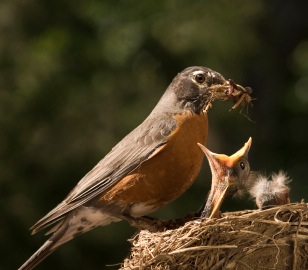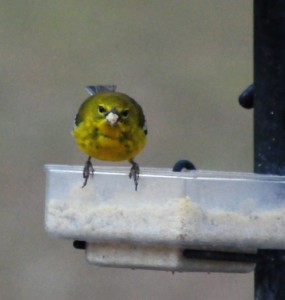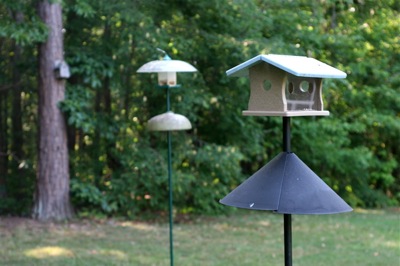-
Smart Robin Sits Under the Mealworm Feeder!
Pretty smart robin… since she can’t enter the traditional fly-in mealworm feeder, she sits directly below it on the ground and waits for escaped worms to drop! Imagine my surprise when I glanced out the window and saw her with a huge mouthful of something… my worms! But she’s got nestlings to feed as well, so hey-whatever works.
Normally live worms are reserved for the bluebirds, but the heat and drought covering most of the country makes it extremely difficult on most wildlife. Actually, crickets, spiders and grasshoppers thrive in these dryer conditions, making it easier for bluebirds and other insect feeding birds. Robins on the other hand, thrive when soils are moist, making their preferred foods more abundant.
One mealworm feeder is an open dish style, that’s where the baby blues first learn to eat on their own. It takes some extra time for them to learn the fly-in feeder. These look more like houses, the worms are inside and there are several entry/exit holes. Luckily nobody else (except for Carolina Wrens) ventures into the feeder. Live worms aren’t too terribly expensive… it’s the shipping that hurts your wallet! Not only must they be shipped via overnight service, but due to high temps, they must be shipped in coolers. This adds size and weight to the delivery-bumping the price even higher. Oh… what we don’t do for our birds!
By the way, during nesting season, it is advised to add calcium if you are supplementing with live worms. Some folks use crushed eggshells, but I’ve never been successful with them. Calcium Carbonate (powder) is inexpensive, and simple to use with worms. Just shake some on the worms to lightly “dust” them prior to feeding. The calcium helps females from becoming egg-bound – eggs actually get stuck in the canal-and it’s fatal too. It also helps fledgelings grow strong bones for a better chance of survival.
- Bird Accessories, Bird Feeders, Birding Accessories, Bluebird Feeders, Fruit, Jelly & Mealworm Feeders, Mealworm Feeder, Uncategorized, Wild Bird Feeders
The dish style mealworm feeder offers various feed options
Hey lady! What’s up with the Mealworm Feeder?
This little plexiglass dish get big traffic in our yard! When live mealworms are placed in it (most times twice a day) all bets are off. The bird traffic is fast and furious, first come, first served!
Originally meant for our Bluebirds – the Chickadees and Titmice quickly learned of the treasure. So, the Bluebirds soon received their own enclosed mealworm feeder, although Carolina Wrens have since figured that out as well!
Feeding live worms can get expensive when everybody’s in on the coveted treat, and I mean everybody! Even the Robins get a few worms in a glass dish that’s left on the ground. And I can’t stand when the crows get to them first!
Unless you have the time and patience to cultivate your own worms, ordering in bulk quantities is easier on the wallet. The worms really aren’t that expensive… it’s the shipping that gets ya! Since they’re live, overnight delivery is required for warmer temperatures. For a few months out of the year (depending on your location) a second-day delivery works fine.
Gradually decreasing the amount of worms, and adding a home-made suet mixture in this meal worm feeder landed a “so-so” reaction from most of our beaked buddies. This Pine Warbler has a mouthful of the stuff, (which is why his beak looks fat & white) but just look at that expression! It’s like “excuse me, where are my worms?”
This mealworm dish actually has drainage, but many similar styles do not, making them perfect for offering water too. In summer, fresh fruit is a great choice for migratory birds, while suet mixtures & crumbles, and shelled peanuts are good options for cold weather feeding.
Offering live worms has created a whole new dimension to our backyard birding experiences. Definitely worth giving it a try if you’ve never fed them before, especially if bluebirds are in the area. And Robins adore them too! But if you don’t want the birds eating you out of house and home… a more traditional, or enclosed mealworm feeder may be your better choice.
- Bird Accessories, Bird Feeders, Bluebird Feeders, Fruit, Jelly & Mealworm Feeders, Live Meal Worms, Mealworm Feeder, Uncategorized
nasty yellow jackets at the mealworm feeder
Lots of bluebirds have passed through this mealworm feeder in our back yard. Last season we had three successful broods of Eastern Bluebirds, in part, thanks to a welcoming habitat. Even the Chickadees, Carolina Wrens and Titmice have learned to use this fly-in mealworm feeder with ease… which I’m not sure is such a good thing? Worms are really reserved for our bluebirds only! This traditional type bluebird feeder is made from recycled plastic, and although it’s about five years old now, it still looks and acts the same way as when it was first installed. With so much junk out there, who doesn’t like quality stuff!
What I am sure of that’s not a good thing are the yellow jackets who continue to torture the live worms inside the feeder! When, for heaven’s sake is it time for them to die off? Every morning when I go to add worms for the patiently waiting, eager bluebirds… the yellow jackets are in there munching on worm remains.
Last night it was in the 20’s here in North Georgia, and finally this morning none of the nasty jax were seen! The weather here is crazy though, hot, cold, warm cold, even some bulbs started forcing their way through the ground with the last dip in temperatures.
I can only hope with this last frost, that all yellow jackets are gone for the season! I think the birds will be happy too 🙂



